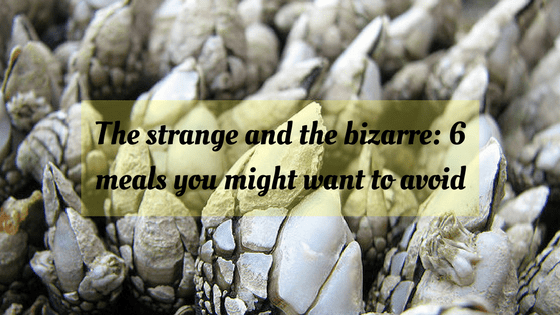THE STRANGE AND THE BIZARRE: 6 MEALS YOU MIGHT WANT TO AVOID

When you go on holiday or travel for long periods, food is often one of the best experiences. Getting to try new flavours and combinations is exciting and a huge part of experiencing a new destination, by getting to know how the locals eat. But not every dish you’ll try abroad will be to your tastes. Some traditional dishes are strange and unusual.
To help you avoid any sour aftertastes, we’ve gathered some meals you might want to avoid while travelling around Spain and the Mediterranean. Check them out:
- Gooseneck barnacles
On the northern coast of Spain, fisherman risk their lives on jagged cliffs to collect gooseneck barnacles, a rare delicacy diners will pay hundreds of euros for. But we’re not sure what all the fuss is about, as they taste so intensely of the sea and not much else.
- Sardinian Maggot Cheese
As the second largest island in the Mediterranean Sea, Sardinia is home to some amazing beaches and clear blue seas, as well rugged mountains and quaint hillside villages. It’s relatively untouched by tourism too – so you can still enjoy the surroundings at your own pace.
However, not everything Sardinia has to offer is worth your time – or the impact on your taste buds. CasuMarzu – known as maggot cheese – is a sheep’s milk cheese with live insect larvae inside it. As the Secret Traveller says, it’s questionable in its legality, but still easy enough to find if you ask around in Sardinia.
- Gazpacho
Gazpacho is traditionally served only in southern Spain in the hot summer months, as it’s a cold, refreshing tomato soup. Nowadays, it’s not really a staple dish in the Spanish diet that people assume it to be. So, Land Lopers warn, it’s not really worth the price you find it for on a restaurant menu, especially as most people buy it in cartons at the local grocery store.
Instead, try Salmorejo. It’s best described as a thicker version of gazpacho, originally from Cordoba in the south of Spain. It’s got way more substance and flavour.
- Grilled pig’s ear
As one of Madrid’s most traditional dishes, some claim Oreja a la plancha (grilled pig ear) is a must-try when you’re in the beautiful city. But whilst they’re a delicacy here, most people will have only seen them fed to dogs as a treat before. You’ll find grilled pigs ears, chopped up and served with a spicy bravas sauce and a cold beer, in most local bars. If you’re feeling brave, you could try this dish.
- Shredded baby eel
Of course, fresh seafood is one of the best things about visiting Spain. Surrounded by around 3,400 kilometres of coastline and numerous groups of islands, it’s not surprising. Seafood paella from the Valencian region, Bullit de Peix fish stew typically from Ibiza, and bacalao pil-pil, salted cod fried in garlic and olive oil, from the Basque Country are all highlights from The Culture Trip.
With so much choice, we recommend avoiding less appealing seafood dishes like angulas, which are baby eels shredded and served fried or sautéed.
- Bull testicles
Madrid is home to many great markets, with locals buying their groceries, all kinds of suppliers delivering merchandise and even lottery ticket sellers. In most of these markets, you’ll be able to find a busy casquería booth. It’s home to the organ meat butcher, and, more often than not, there’s a long line of people waiting for their sheep brains and pig hearts. It’s here you’ll also find the oval shaped specimens that you’re afraid to ask about– bull testicles.
What Spanish dishes have you tried? Share your tips with us!
